Chapters >> 1 - 3 | 4 - 6 | 7 - 10 | 11 - 13 | 14 - 16 | 17 - 19 | Giglist
"Inget nytt under solen" was released in December 1976 to great critical acclaim. Kaipa's music was often compared to that of GENESIS and YES; this hardly came as a surprise to the band, accustomed as they were to the critical habit of judging records in comparison to others. Kaipa had nonetheless evolved their own distinctive style; if journalists still identified their music with YES' symphonic rock, it was merely due to a common source of inspiration- classical music. Kaipa's second album, however, proved that comparisons are odious; so genuinely original had their music become that one couldn't compare their work with their models. The album even reached the top-50 charts at number 49 for one week, which was very unusual for this type of music. 10,000 copies of were sold in Scandinavia, outside of which it wasn't exported.
The band played their first national TV broadcast around this time, performing their ´crowd-pleaser` "Korståg" to much favourable response; they also played live for Malmö and Stockholm radio stations. In spite of their increasingly tight schedule they still rehearsed daily. Tomas and Ingemar went to England to buy extra sound material, acquiring a new mixing desk and a double-neck bass guitar built for GENESIS' MIKE RUTHERFORD. The band also equipped themselves with a Moog Taurus pedal board and Roine tried out the very first guitar synthesizer, made by Hagstrom/Oberheim and used also by FRANK ZAPPA. Hans got a minimoog directly from Moog's U.S. factory, and also tested the new Polymoog.
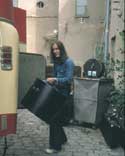
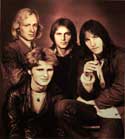
In October 1977 Tomas announced his decision to leave the band, citing ´musical differences` as the cause. Kaipa were thus reduced to a trio once again.
The band was now forced to do some serious thinking about the future; some songs from "Inget nytt" had just been recorded with English lyrics with the aim of breaking the band on the international market. Tomas' departure, however, had thrown the group into crisis.
With their second album, Kaipa established itself as one of the essential Swedish progressive bands of the era, on par with the best international groups in this style of music.
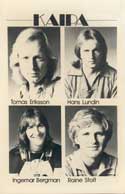
Roine considered Magnus Uggla, a highly theatrical singer. He'd released two albums on CBS, and although he hadn't enjoyed much success, his qualities as a performer were plain to see. Live, his stagecraft could offer something new to Kaipa, a band that didn't care much for onstage trickery, apart from the periodic interventions of Ingemar. Nevertheless, Kaipa never contacted Magnus, who subsequently went on to become one of Sweden's most popular singers.
Another singer the group toyed with was Derek Hudson of the folk-rock group Scafell Pike but in the end they plumped for Mats Löfgren, a member of the jazz-rock group Rio Brazzaville and a friend of Ingemar's. After a few conclusive try-outs and demo recordings, Kaipa welcomed him into the fold in October 1977. Mats also had the advantage of being a guitarist and percussionist, and later on he played these instruments live with the band. Nor did Mats bother with visual gimmicks, make-up or costumes - rather like Kaipa themselves.
Hans, who up until then had handled vocals, had a very distinctive voice, but Mats had a deeper tone and a different timbre. The band's followers were suspicious of the change at first but soon grew to appreciate Mats' qualities as a singer. After a while the band's fans adopted him as they got used to the change in the look and sound of the group.
After Tomas Eriksson left, the band had the opportunity to ask Lars Hoflund to join up, but he preferred playing blues, and could at the time earn much more playing with Tomas Ledin. Kaipa then called up Mats Lindberg, a schoolmate of Roine who was only 18 years old at that time. Roine and Ingemar knew of his qualities as a bassist, having jammed with him in their rehearsal room. He was also a nice guy and was equally at home playing guitar. He could play 12-string and was able to handle the double-neck guitar left by Tomas. He joined in November 1977.
Tomas' characteristic bass sound and lines had been very much a part of the original Kaipa sound. The group with its two new members, decided to make up for this very considerable absence by throwing themselves into their work, investing all their energy in a new album. By now, having gained quite a reputation as Sweden's premier prog outfit, Kaipa determined to cut an album a year to satisfy the demand and sustain the interest of their public.
Throughout the autumn of 1977, Kaipa worked on new songs and set about rehearsing and perfecting them. At this time Hans had some basic ideas for another epic song like "Skenet bedrar", but he needed the band to carry out his ideas like they had previously. Roine, on the other hand, had grown in his writing and arranging. He could present his new songs in plain terms and give clear instructions to the players, which produced an immediate result. This lead to a completely different way of working in the new band. The new members had almost no connection or relationship with the basic structure in the former Kaipa music. In fact the new band was subdividing into fractions at this time. Roine and Mats Lindberg formed one group, Ingemar and Mats Löfgren another leaving Hans alone in the background. Roine appreciated some of Hans' small pieces like "Tajgan" (The Taiga), "En igelkotts död" (The Death of a Hedgehog) and " Visan i Sommaren" (A Summer Air). He persuaded the others to accept these songs. They relied on melodic traditions and needed no large arrangements. The basic idea of "the epic song" was presented in a simple version by Hans on the organ but the others quickly rejected it and so it fell into oblivion. It was a time of many new music styles including funk, fusion and jazz-rock and several members were leaning more towards that style and even the simpler style of bands like The Eagles, ABBA, Queen, Bad Company and Fleetwood Mac. There was much ambition in the pipeline at that time and the wish for more success of course propelled the members into dissension about how to achieve it. It turned out to be Roine's composing that got most of the interest when compiling the new album, maybe because the time was right or simply because he had more developed demos and ideas. This new way of working, with separate fractions asserting their own interests, disturbed the old balance that was so successful, and it was the beginning of an era that would split the main forces of the original Kaipa completely a year and a half later.
For the new album Kaipa utilised for the first time pre-production techniques, at that time a little-used process. Firstly the band laid down the tracks on demos on a cheap 4-track recorder in October and November 1977. During these sessions, they worked for the first time with some new instruments. Hans played a Poly Moog and Mats used a Moog bass pedal. Roine tried out a new guitarsynth manufactured by the Swedish company Hagstroem in collaboration with Ampeg. A few of the songs originally had English lyrics but the band decided to rewrite them in Swedish. Their efforts to break the international market with an English language version of "Inget nytt under solen" hadn't succeeded, and so Kaipa reverted to their native language.
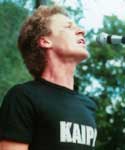


Roine used some guitar effects, running it backwards, multilayering etc., as practised by players such BRIAN MAY of QUEEN. He used a Fender Stratocaster and a very rare Melody Maker as well as an Ovation acoustic in addition to his own instruments. All his guitar work was treated through a customized pedal-board and run through a new Roland Jazz Chorus Amp. He also resorted to the aforementioned guitar-synth with an Oberheim expander, a customised talk-box and an HH echoplex. Hans used a wide range of keyboards - mini and poly moogs, Korg String 2000, mellotron, Hohner Clavinet, grand piano, Hammond organ and Fender electric piano. Mats Lindberg played a Fender Precision bass, the double-neck Shergold guitar and a Danelectro fretless bass with Moog pedals and Sunn Amps.
Mixing took place between 3 and 5 January 1978. The album was produced by the band and Olle Ramm. It contained even fewer reverb effects than before and the guitar and drums were more to the fore on the soundstage of the record.
The album sleeve was designed by Lars Holm, an artist and friend of the group's who'd given him carte blanche as to the design. The frame of the design was much inspired by JACKSON BROWNE's "Pretender" album. One of the characters in Lars' painting was later to be called "SOLO", just because the band decided to call the album that name after some serious brainstorming. Releasing "Solo" Electra swung into action behind the album, making a great promotional effort with attractive stickers and posters and lots of newspaper advertising.
The album came out in May 1978. It didn't enjoy the immediate success of "Inget nytt under solen" but gradually attained a sales figure of 10,000 copies. In fact, the release of the album, at the start of the Swedish summer, had been very badly timed. The press were highly laudatory, and the band's concerts were invariably sold out. Kaipa had clearly "arrived" as a major Swedish group.
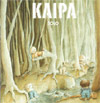
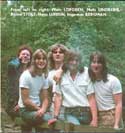
Chapters >> 1 - 3 | 4 - 6 | 7 - 10 | 11 - 13 | 14 - 16 | 17 - 19 | Giglist